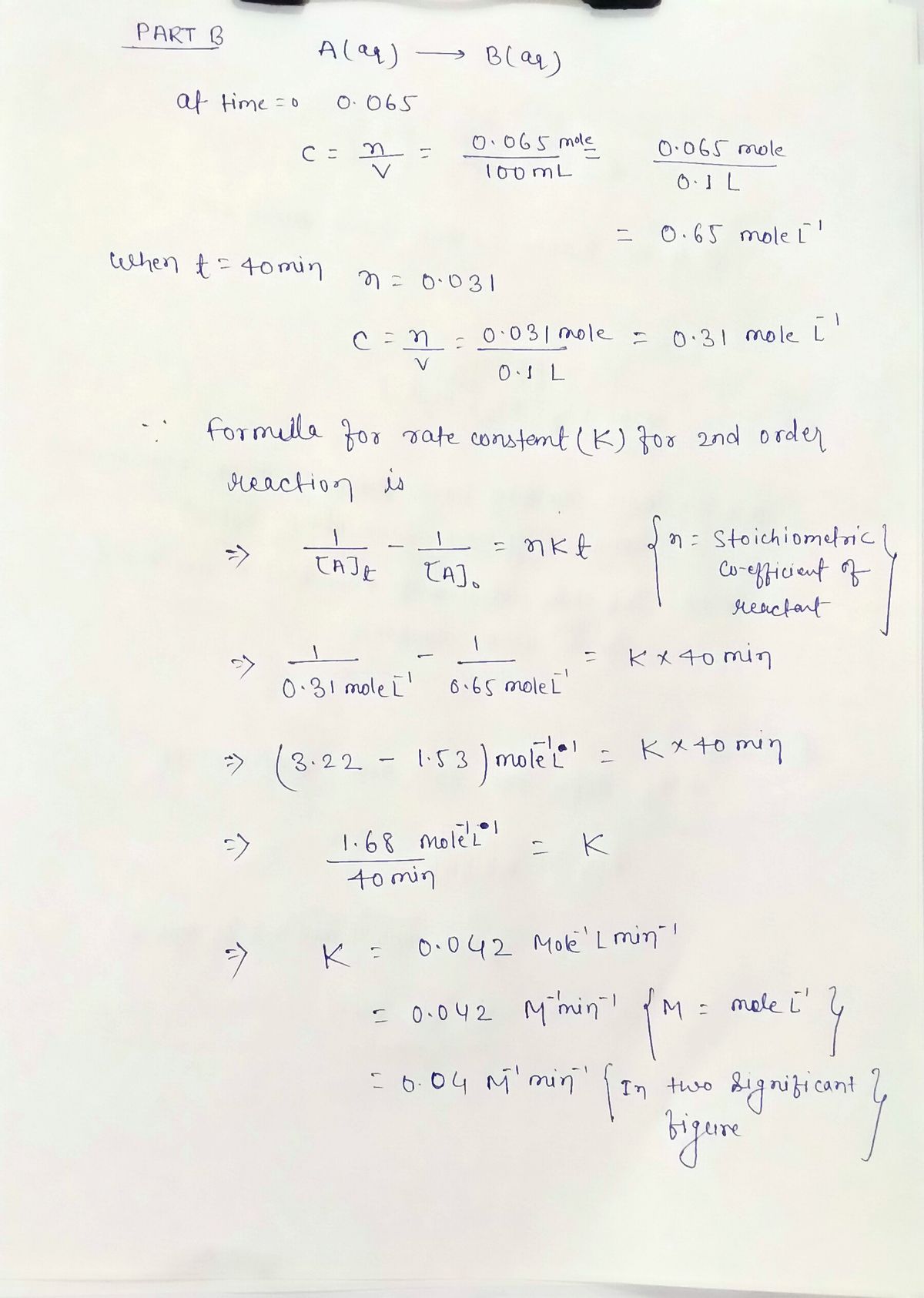Consider the following hypothetical aqueous reaction: A(ag) –→B(ag). A flask is charged with 0.065 mol of A in a total volume of 100.0 mL. The following data are collected: O This is the first order reaction. O This is the second order reaction. Time (min) 0 20 30 10 40 Moles of A 0.065 0.051 0.042 0.036 0.031 Submit Previous Answers v Correct Part B What is the rate constant for the reaction? Express your answer using two significant figures. Πνα ΑΣφ k = 0.419 М min 1 Submit Previous Answers Request Answer X Incorrect; Try Again; 25 attempts remaining Consider the following hypothetical aqueous reaction: A(ag) – B(ag). A flask is charged with 0.065 mol of A in a total volume of 100.0 mL. The k = 0.419 м 1 min 1 following data are collected: Time (min) |0 10 20 30 40 Submit Previous Answers Request Answer Moles of A 0.065 0.051 0.042 0.036 0.031 X Incorrect; Try Again; 25 attempts remaining Part C What is the half-life for the reaction? Express your answer using two significant figures. t/2 = 0.99 min Submit Previous Answers Request Answer X Incorrect; Try Again; 28 attempts remaining P Pearson
Consider the following hypothetical aqueous reaction: A(ag) –→B(ag). A flask is charged with 0.065 mol of A in a total volume of 100.0 mL. The following data are collected: O This is the first order reaction. O This is the second order reaction. Time (min) 0 20 30 10 40 Moles of A 0.065 0.051 0.042 0.036 0.031 Submit Previous Answers v Correct Part B What is the rate constant for the reaction? Express your answer using two significant figures. Πνα ΑΣφ k = 0.419 М min 1 Submit Previous Answers Request Answer X Incorrect; Try Again; 25 attempts remaining Consider the following hypothetical aqueous reaction: A(ag) – B(ag). A flask is charged with 0.065 mol of A in a total volume of 100.0 mL. The k = 0.419 м 1 min 1 following data are collected: Time (min) |0 10 20 30 40 Submit Previous Answers Request Answer Moles of A 0.065 0.051 0.042 0.036 0.031 X Incorrect; Try Again; 25 attempts remaining Part C What is the half-life for the reaction? Express your answer using two significant figures. t/2 = 0.99 min Submit Previous Answers Request Answer X Incorrect; Try Again; 28 attempts remaining P Pearson
Chemistry
10th Edition
ISBN:9781305957404
Author:Steven S. Zumdahl, Susan A. Zumdahl, Donald J. DeCoste
Publisher:Steven S. Zumdahl, Susan A. Zumdahl, Donald J. DeCoste
Chapter1: Chemical Foundations
Section: Chapter Questions
Problem 1RQ: Define and explain the differences between the following terms. a. law and theory b. theory and...
Related questions
Question
part b and c

Transcribed Image Text:Consider the following hypothetical aqueous
reaction: A(ag) –→B(ag). A flask is charged with
0.065 mol of A in a total volume of 100.0 mL. The
following data are collected:
O This is the first order reaction.
O This is the second order reaction.
Time (min) 0
20
30
10
40
Moles of A 0.065 0.051 0.042 0.036 0.031
Submit
Previous Answers
v Correct
Part B
What is the rate constant for the reaction?
Express your answer using two significant figures.
Πνα ΑΣφ
k = 0.419
М min 1
Submit
Previous Answers Request Answer
X Incorrect; Try Again; 25 attempts remaining

Transcribed Image Text:Consider the following hypothetical aqueous
reaction: A(ag) – B(ag). A flask is charged with
0.065 mol of A in a total volume of 100.0 mL. The
k = 0.419
м 1 min 1
following data are collected:
Time (min) |0
10
20
30
40
Submit
Previous Answers Request Answer
Moles of A 0.065 0.051 0.042 0.036 0.031
X Incorrect; Try Again; 25 attempts remaining
Part C
What is the half-life for the reaction?
Express your answer using two significant figures.
t/2 = 0.99
min
Submit
Previous Answers Request Answer
X Incorrect; Try Again; 28 attempts remaining
P Pearson
Expert Solution
Step 1

Trending now
This is a popular solution!
Step by step
Solved in 2 steps with 2 images

Knowledge Booster
Learn more about
Need a deep-dive on the concept behind this application? Look no further. Learn more about this topic, chemistry and related others by exploring similar questions and additional content below.Recommended textbooks for you

Chemistry
Chemistry
ISBN:
9781305957404
Author:
Steven S. Zumdahl, Susan A. Zumdahl, Donald J. DeCoste
Publisher:
Cengage Learning

Chemistry
Chemistry
ISBN:
9781259911156
Author:
Raymond Chang Dr., Jason Overby Professor
Publisher:
McGraw-Hill Education

Principles of Instrumental Analysis
Chemistry
ISBN:
9781305577213
Author:
Douglas A. Skoog, F. James Holler, Stanley R. Crouch
Publisher:
Cengage Learning

Chemistry
Chemistry
ISBN:
9781305957404
Author:
Steven S. Zumdahl, Susan A. Zumdahl, Donald J. DeCoste
Publisher:
Cengage Learning

Chemistry
Chemistry
ISBN:
9781259911156
Author:
Raymond Chang Dr., Jason Overby Professor
Publisher:
McGraw-Hill Education

Principles of Instrumental Analysis
Chemistry
ISBN:
9781305577213
Author:
Douglas A. Skoog, F. James Holler, Stanley R. Crouch
Publisher:
Cengage Learning

Organic Chemistry
Chemistry
ISBN:
9780078021558
Author:
Janice Gorzynski Smith Dr.
Publisher:
McGraw-Hill Education

Chemistry: Principles and Reactions
Chemistry
ISBN:
9781305079373
Author:
William L. Masterton, Cecile N. Hurley
Publisher:
Cengage Learning

Elementary Principles of Chemical Processes, Bind…
Chemistry
ISBN:
9781118431221
Author:
Richard M. Felder, Ronald W. Rousseau, Lisa G. Bullard
Publisher:
WILEY